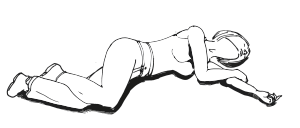Lying (position)

Lying, also called recumbency or prostration, or decubitus in medicine (from the Latin verb decumbere ′to lie down′), is a type of human position in which the body is more or less horizontal and supported along its length by the surface underneath. Lying is the most common position while being immobilized, e.g. in bedrest while sleeping or being struck by injury or disease.
Lying positions


When lying, the body may assume a great variety of shapes and positions. The following are the basic recognized ones.
- Supine: lying on the back with the face up.
- Prone: lying on the chest with the face down ("lying down" or "going prone"). See also "Prostration".
- Lying on either side, with the body straight or bent/curled forward or backward.
- The fetal position is lying or sitting curled, with limbs close to the torso and the head close to the knees.
- The recovery position (coma position), one of a series of variations on a lateral recumbent or three-quarters prone position of the body, into which an unconscious but breathing casualty can be placed as part of first aid treatment.
When medical professionals use this term to describe the position of a patient, they first state the part of the body on which the patient is resting followed by the word decubitus. For example, the right lateral decubitus would mean that the patient is lying on his or her right side. Left lateral decubitus position (LLDP) would mean that the patient is lying on his or her left side.
Another example is angina decubitus 'chest pain while lying down'.[1]
In radiology, this term implies that the patient is lying down with the X-ray being taken parallel to the horizon.[2]
As a treatment
Bedrest as a medical treatment refers to staying in bed day and night as a treatment for an illness or medical condition, especially when prescribed or chosen rather than resulting from severe prostration or imminent death. Even though most patients in hospitals spend most of their time in the hospital beds, bedrest more often refers to an extended period of recumbence at home.
Long-term risks
Prolonged bedrest carries some medical risks such as decubitus ulcers, demineralization of the bones and atrophy of the muscles, as well as economic and social costs, and is much less commonly prescribed today than it formerly used to be. Preterm labor with threatened miscarriage remains one of the few conditions for which bedrest remains a standard treatment.
It is also a major cause of thrombosis.[3]
See also
References
- ↑ Quia Directional Terms and Body Positions
- ↑ Indiana University powerpoint presentation on positioning terms
- ↑ Chapter 4 in: Mitchell, Richard Sheppard; Kumar, Vinay; Abbas, Abul K.; Fausto, Nelson. Robbins Basic Pathology: With STUDENT CONSULT Online Access. Philadelphia: Saunders. ISBN 1-4160-2973-7. 8th edition.